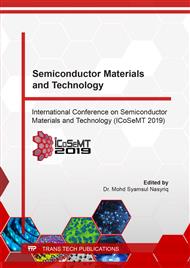[1]
O. Gordobil, I. Egüés, I. Urruzola, and J. Labidi, Xylan–cellulose films: Improvement of hydrophobicity, thermal and mechanical properties,, Carbohydrate polymers, vol. 112, pp.56-62, (2014).
DOI: 10.1016/j.carbpol.2014.05.060
Google Scholar
[2]
I. Egüés, A. M. Stepan, A. Eceiza, G. Toriz, P. Gatenholm, and J. Labidi, Corncob arabinoxylan for new materials,, Carbohydrate polymers, vol. 102, pp.12-20, (2014).
DOI: 10.1016/j.carbpol.2013.11.011
Google Scholar
[3]
M. S. Madruga, F. S. M. de Albuquerque, I. R. A. Silva, D. S. do Amaral, M. Magnani, and V. Q. Neto, Chemical, morphological and functional properties of Brazilian jackfruit (Artocarpus heterophyllus L.) seeds starch,, Food chemistry, vol. 143, pp.440-445, (2014).
DOI: 10.1016/j.foodchem.2013.08.003
Google Scholar
[4]
Y.-M. Tao, S. Wang, H.-L. Luo, and W.-W. Yan, Peroxidase from jackfruit: Purification, characterization and thermal inactivation,, International journal of biological macromolecules, vol. 114, pp.898-905, (2018).
DOI: 10.1016/j.ijbiomac.2018.04.007
Google Scholar
[5]
S.-Y. Xu, J.-P. Liu, X. Huang, L.-P. Du, F.-L. Shi, R. Dong, et al., Ultrasonic-microwave assisted extraction, characterization and biological activity of pectin from jackfruit peel,, LWT, vol. 90, pp.577-582, (2018).
DOI: 10.1016/j.lwt.2018.01.007
Google Scholar
[6]
A. A. Sundarraj and T. V. Ranganathan, Physicochemical characterization of jackfruit (Artocarpus integer (Thumb.).),, RESEARCH JOURNAL OF PHARMACEUTICAL BIOLOGICAL AND CHEMICAL SCIENCES, vol. 8, pp.2285-2295, (2017).
Google Scholar
[7]
S. Deng, R. Huang, M. Zhou, F. Chen, and Q. Fu, Hydrophobic cellulose films with excellent strength and toughness via ball milling activated acylation of microfibrillated cellulose,, Carbohydrate polymers, vol. 154, pp.129-138, (2016).
DOI: 10.1016/j.carbpol.2016.07.101
Google Scholar
[8]
G. Fan, M. Wang, C. Liao, T. Fang, J. Li, and R. Zhou, Isolation of cellulose from rice straw and its conversion into cellulose acetate catalyzed by phosphotungstic acid,, Carbohydrate polymers, vol. 94, pp.71-76, (2013).
DOI: 10.1016/j.carbpol.2013.01.073
Google Scholar
[9]
A. Ashori, M. Babaee, M. Jonoobi, and Y. Hamzeh, Solvent-free acetylation of cellulose nanofibers for improving compatibility and dispersion,, Carbohydrate polymers, vol. 102, pp.369-375, (2014).
DOI: 10.1016/j.carbpol.2013.11.067
Google Scholar
[10]
W. Rodríguez-Castellanos, D. Rodrigue, F. Martínez-Bustos, O. Jiménez-Arévalo, and T. Stevanovic, Production and characterization of gelatin-starch polymer matrix reinforced with cellulose fibers,, Polymers from Renewable Resources, vol. 6, pp.105-118, (2015).
DOI: 10.1177/204124791500600303
Google Scholar
[11]
P. Koh, C. Leong, and M. Noranizan, Microwave-assisted extraction of pectin from jackfruit rinds using different power levels,, International Food Research Journal, vol. 21, (2014).
Google Scholar
[12]
S. Razak, W. Rahman, and N. Majid, Effect of jackfruit rind-based cellulose (JR-CEL.) on physical and mechanical properties of the biodegradable glycerol/gelatine matrix film,, in AIP Conference Proceedings, 2018, p.020075.
DOI: 10.1063/1.5062701
Google Scholar
[13]
A. Bello, M. T. Isa, B. O. Aderemi, and B. Mukhtar, Acetylation of cotton stalk for cellulose acetate production,, American Scientific Research Journal for Engineering, Technology, and Sciences (ASRJETS), vol. 15, pp.137-150, (2016).
Google Scholar
[14]
H. M. Shaikh, K. V. Pandare, G. Nair, and A. J. Varma, Utilization of sugarcane bagasse cellulose for producing cellulose acetates: Novel use of residual hemicellulose as plasticizer,, Carbohydrate Polymers, vol. 76, pp.23-29, (2009).
DOI: 10.1016/j.carbpol.2008.09.014
Google Scholar
[15]
M. Gomaa, A. F. Hifney, M. A. Fawzy, and K. M. Abdel-Gawad, Use of seaweed and filamentous fungus derived polysaccharides in the development of alginate-chitosan edible films containing fucoidan: Study of moisture sorption, polyphenol release and antioxidant properties,, Food Hydrocolloids, vol. 82, pp.239-247, (2018).
DOI: 10.1016/j.foodhyd.2018.03.056
Google Scholar
[16]
A. Ayoub, R. A. Venditti, J. J. Pawlak, H. Sadeghifar, and A. Salam, Development of an acetylation reaction of switchgrass hemicellulose in ionic liquid without catalyst,, Industrial crops and Products, vol. 44, pp.306-314, (2013).
DOI: 10.1016/j.indcrop.2012.10.036
Google Scholar
[17]
A. N. Adilah, B. Jamilah, M. Noranizan, and Z. N. Hanani, Utilization of mango peel extracts on the biodegradable films for active packaging,, Food packaging and shelf life, vol. 16, pp.1-7, (2018).
DOI: 10.1016/j.fpsl.2018.01.006
Google Scholar
[18]
A. Golachowski, T. Zięba, M. Kapelko-Żeberska, W. Drożdż, A. Gryszkin, and M. Grzechac, Current research addressing starch acetylation,, Food chemistry, vol. 176, pp.350-356, (2015).
DOI: 10.1016/j.foodchem.2014.12.060
Google Scholar
[19]
J. A. Á. Ramírez, C. G. Hoyos, S. Arroyo, P. Cerrutti, and M. L. Foresti, Acetylation of bacterial cellulose catalyzed by citric acid: Use of reaction conditions for tailoring the esterification extent,, Carbohydrate polymers, vol. 153, pp.686-695, (2016).
DOI: 10.1016/j.carbpol.2016.08.009
Google Scholar
[20]
Y. Zhang, S. Yang, J.-Q. Wu, T.-Q. Yuan, and R.-C. Sun, Preparation and characterization of lignocellulosic oil sorbent by hydrothermal treatment of Populus fiber,, Materials, vol. 7, pp.6733-6747, (2014).
DOI: 10.3390/ma7096733
Google Scholar
[21]
G. Tedeschi, S. Guzman-Puyol, U. C. Paul, M. J. Barthel, L. Goldoni, G. Caputo, et al., Thermoplastic cellulose acetate oleate films with high barrier properties and ductile behaviour,, Chemical Engineering Journal, vol. 348, pp.840-849, (2018).
DOI: 10.1016/j.cej.2018.05.031
Google Scholar
[22]
R. Candido, G. Godoy, and A. R. Gonçalves, Characterization and application of cellulose acetate synthesized from sugarcane bagasse,, Carbohydrate polymers, vol. 167, pp.280-289, (2017).
DOI: 10.1016/j.carbpol.2017.03.057
Google Scholar
[23]
S. Gemili, A. Yemenicioğlu, and S. A. Altınkaya, Development of cellulose acetate based antimicrobial food packaging materials for controlled release of lysozyme,, Journal of Food Engineering, vol. 90, pp.453-462, (2009).
DOI: 10.1016/j.jfoodeng.2008.07.014
Google Scholar
[24]
R. Singanusong, W. Tochampa, T. Kongbangkerd, and C. Sodchit, Extraction and properties of cellulose from banana peels,, Suranaree Journal of Science and Technology, vol. 21, pp.201-213, (2014).
Google Scholar
[25]
W. A. Rahman, S. N. A. Sudin, and S. N. Din, Physical and mechanical properties of Pandanus amaryllifolius fiber reinforced low density polyethylene composite for packaging application,, in 2012 IEEE Symposium on Humanities, Science and Engineering Research, 2012, pp.345-349.
DOI: 10.1109/shuser.2012.6268868
Google Scholar


